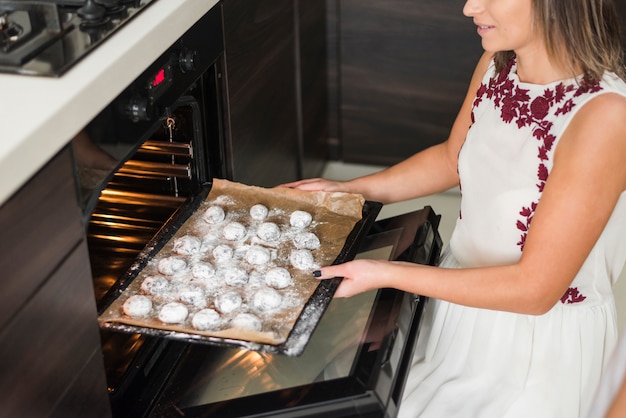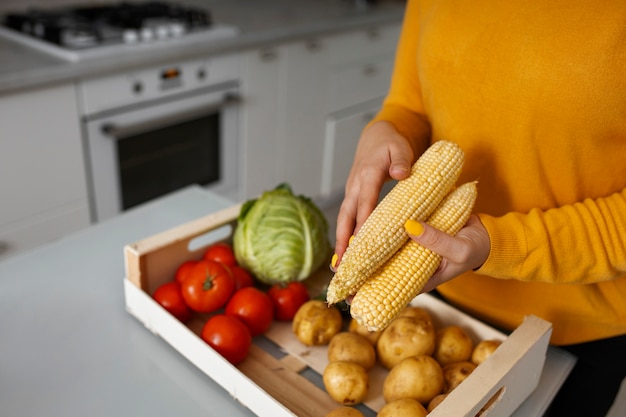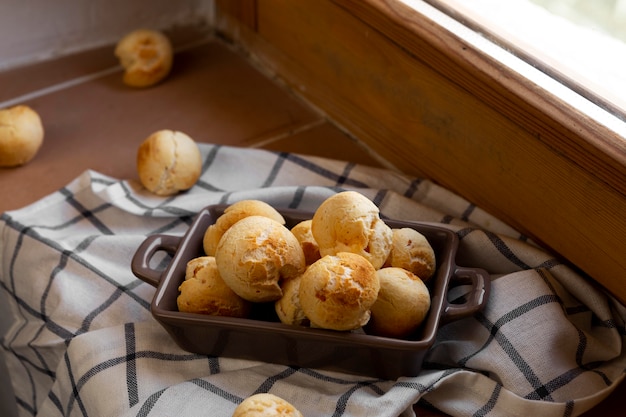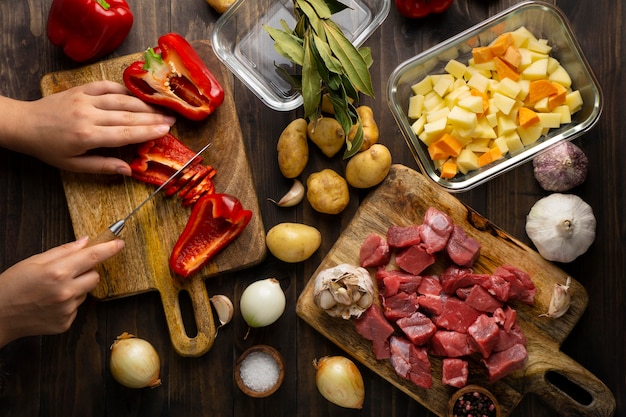Let's talk about yams! Okay, I know, "yam" can be a bit of a loaded word. Some folks swear by "sweet potato," others insist on "yam." Honestly, I'm all about deliciousness, and a perfectly baked yam (or sweet potato, if you prefer) is a true delight. It's a simple pleasure that can be incredibly satisfying, but getting it just right can be a little tricky. So, buckle up, because I'm about to share my insider tips and tricks to guarantee your yams are baked to absolute perfection.
(Part 1) The Great Yam Debate: Setting the Record Straight

Before we dive into the baking process, let's clear the air about this whole "yam" vs. "sweet potato" thing. It's a common source of confusion, but the truth is, they're actually two distinct vegetables, though they're often used interchangeably. I was surprised too when I learned this, but now I'm on a mission to spread the knowledge!
The Real Deal: Yams
True yams belong to the Dioscorea family and are usually pretty starchy and dry. They've got a rough, brown skin and pale yellow or white flesh. You're less likely to find them at your local grocery store because they're mostly grown in tropical climates. But if you ever stumble upon them, give them a try! They have a unique flavour and texture.
sweet potatoes: The Common Misnomer
The ones we usually find in supermarkets and bake are actually sweet potatoes, belonging to the Ipomoea family. They're the real stars of the show! Sweet potatoes come in a wide range of colours and shapes, but they're typically known for their orange flesh, which is what most recipes are referring to when they call for "yams." They're known for their moist texture and slightly sweet flavour, making them a versatile ingredient for everything from savoury dishes to sweet treats.
Choosing Your Yam (Or Sweet Potato): It's All About Taste!
So, what should you call them? Honestly, call them whatever you like! My philosophy is simple: if it tastes good, it's good. But for the sake of clarity, we'll be focusing on the orange-fleshed sweet potato throughout this guide, as it's the one we're most likely to find and bake. But if you're ever lucky enough to find a true yam, give it a go. You might be surprised at how delicious it is.
(Part 2) Picking the Perfect Yams: Finding the Right Fit

Now that we've cleared the air about the "yam" dilemma, let's focus on picking the best sweet potatoes for baking. This is a crucial step, as it sets the stage for perfect results. Here's what to keep in mind when you're at the supermarket:
Size Matters: Finding the Goldilocks Yam
Look for yams that are roughly the same size, ideally medium-sized. This helps ensure even cooking, so everyone gets a chance to reach that perfect texture. If you've got a mix of sizes, no problem! Just bake the larger ones for a bit longer to make sure they're fully cooked through.
Firm and Fresh: The Feel Test
Avoid yams that feel soft or have any bruises or damage. A good yam should be firm to the touch and have a smooth, even skin. This is a good indication of freshness and quality.
Colour and Shape: The Visual Inspection
While the colour and shape of your yams won't affect their flavour, it's worth taking a moment to assess them visually. Look for yams that have a consistent colour throughout and are free of blemishes. If the skin is dull or discoloured, it might be a sign that the yam is getting old. So, choose those with a vibrant, healthy look.
(Part 3) Preparing Your Yams: A Few Simple Steps for Success

Now you've got your perfect yams, it's time to get them ready for baking. Don't worry, this part is pretty straightforward, but it's essential for ensuring a smooth and delicious baking process.
Washing and Scrubbing: Clean and Ready to Bake
Before you even think about peeling or chopping, give your yams a good wash with a vegetable brush. You want to remove any dirt or debris that might be clinging to the skin. Some people actually prefer to leave the skin on during baking, as it adds a bit of texture and flavour. So, if you're feeling adventurous, give it a try! It's a great way to add a bit of rustic charm to your baked yams.
Peeling and Cutting: A Matter of Preference
If you're going for a peeled yam, use a sharp knife to remove the skin. You can cut the yams into chunks or wedges, depending on your preference. I typically cut them into about 2-inch chunks, but you can adjust this based on the size of the yam and your desired outcome. Remember, there's no right or wrong way to do this, so feel free to experiment!
Adding a Touch of Sweetness: A Little Extra Delight
Here's a little secret I've learned over the years: drizzling a touch of maple syrup or honey over your cut yams before baking adds a subtle sweetness that really enhances the flavour. It also helps to prevent them from drying out, ensuring a perfectly moist and tender texture. Just remember, a little goes a long way! So, start with a small amount and adjust to your liking.
(Part 4) The Baking Process: Timing is Key for Perfection
Alright, we're finally at the heart of the matter: baking! This is where patience and a watchful eye are crucial. Follow these steps to bake your yams to absolute perfection.
Preheating the Oven: The Foundation for Even Cooking
Preheat your oven to 400°F (200°C). This is an essential step for ensuring even cooking, especially for root vegetables like yams. If you skip this step, your yams might end up unevenly cooked, with some parts mushy and others still firm. Trust me, preheating is worth the extra minute or two.
Choosing Your Baking Dish: Making the Right Choice
You've got a few options when it comes to baking dishes. I personally prefer a baking sheet lined with parchment paper. It allows for even airflow, making for consistently cooked yams, and makes cleanup a breeze. But if you don't have parchment paper, you can use a roasting pan or even a casserole dish. Just make sure the dish is large enough to accommodate the yams with some space around them, allowing for even heat distribution.
Baking Time and Temperature: A Guide to Perfection
The baking time will depend on the size of your yams. Here's a general guide to get you started:
- Small yams (about 4-6 inches long): 30-40 minutes
- Medium yams (about 6-8 inches long): 40-50 minutes
- Large yams (about 8-10 inches long): 50-60 minutes
Checking for Doneness: The Fork Test
The best way to know when your yams are done is to use the trusty fork test. Insert a fork into the thickest part of the yam. If it goes in easily and the yam feels soft to the touch, you're good to go. But if it's still a bit firm, give it another 5-10 minutes in the oven and check again. It's better to err on the side of caution and make sure those yams are fully cooked through.
(Part 5) Beyond the Basics: Adding a Touch of Creativity
Now that you've mastered the fundamentals, it's time to get creative! Experiment with these delicious variations and flavour combinations to elevate your baked yams to new heights.
Sweet and Savoury: Balancing Flavours
You can enhance the natural sweetness of your yams by drizzling them with a touch of maple syrup or honey before baking. For a savoury twist, roast them with garlic, onions, and herbs like rosemary or thyme. The combination of sweetness and savoury flavours creates a delightful contrast that's sure to impress.
Spiced Up: Adding a Touch of Heat
Give your yams a flavour kick by adding spices like cinnamon, nutmeg, or ginger. You can sprinkle them on top or mix them into a glaze. For a bit of a spicy kick, try a pinch of cayenne pepper. Experiment with different combinations to find your favourite spice blend. I like to use a mix of cinnamon, nutmeg, and a hint of ginger for a warm and comforting flavour.
Tropical Vibes: A Taste of Paradise
Embrace the tropics by baking your yams with coconut milk and a sprinkle of toasted coconut flakes. The combination of coconut and yam is light, refreshing, and bursting with flavour. It's a fantastic way to create a taste of paradise right in your own kitchen. You can even add a little bit of lime zest for an extra touch of citrusy goodness.
(Part 6) Serving Up Your Baked Yams: Endless Possibilities
Once those yams are perfectly baked, it's time to enjoy! Here are some ideas for serving them up in a way that will impress your taste buds.
Simple and Delicious: The Classic Approach
Enjoy your baked yams straight out of the oven, topped with a pat of butter or a dollop of Greek yogurt. A sprinkle of cinnamon or nutmeg adds a warm and comforting touch. This simple and classic combination is a real crowd-pleaser.
side dish Star: The Perfect Complement
Baked yams make a fantastic side dish for any meal. They pair perfectly with roasted chicken, pork, fish, and even vegetarian dishes. I love to serve them alongside a simple salad or roasted vegetables for a balanced and satisfying meal. The sweet and earthy flavour of the yams complements a wide range of proteins and vegetables, making them a versatile addition to any table.
Sweet and Savoury Bowls: A Delicious Fusion
Combine your baked yams with other ingredients to create delicious and nutritious bowls. Try them with black beans, avocado, corn, and a sprinkle of cilantro for a hearty and flavourful meal. You can also add a drizzle of lime juice and a pinch of chili powder for a tangy and spicy kick. The possibilities are endless! Get creative and experiment with different combinations to discover your favourite bowl variations.
(Part 7) Storing and Reheating: Keeping Those Yams Delicious
If you're not planning on eating all your baked yams right away, no worries! They can be stored in an airtight container in the refrigerator for up to 3 days. You can also freeze them for up to 3 months. To reheat, simply place them in a preheated oven at 350°F (175°C) for 15-20 minutes, or until warmed through. They'll taste just as good as fresh!
(Part 8) Beyond the Oven: Expanding Your Yam Horizons
While baking is a classic way to enjoy yams, it's certainly not the only option! Here are a few other methods to explore:
Mashed Yam Delight: A Versatile Base
Mash your baked yams and use them as a base for soups, stews, or even as a sweet potato puree for desserts. They're delicious with a little butter, salt, and pepper. You can also add a touch of maple syrup or cinnamon to enhance the sweetness. This mashed yam base is a great way to add a creamy and flavorful element to your dishes.
Yams in a Smoothie: A Boost of Nutrition
Add a touch of sweetness and nutritional value to your smoothies by blending in cooked or even raw yam. It blends well with other fruits and vegetables, creating a delicious and satisfying smoothie that's packed with vitamins and minerals. Try adding a yam to your favourite smoothie recipes for a flavourful and healthy twist.
Crispy Yam Fries: A Healthier Treat
Cut yams into french fry-like shapes, toss them in olive oil and spices, and bake them until crispy. They're a healthier alternative to traditional fries and just as delicious. Experiment with different seasonings and herbs to find your perfect yam fry combination. You can even serve them with a dipping sauce for an extra flavour boost.
(Part 9) FAQs: Addressing Your Questions
Here are some frequently asked questions about baking yams to help you avoid any baking blunders:
Q: Can I bake yams with the skin on?
Absolutely! Some people prefer to leave the skin on during baking, as it adds a bit of texture and flavour. Just make sure to wash and scrub the yams thoroughly before baking. This can also be a great way to add a rustic touch to your presentation. The skin is edible and adds a bit of a chewy texture.
Q: How can I tell if my yams are overcooked?
Overcooked yams will be mushy and dry. If you're unsure, check them with a fork. If it goes in easily and the yam feels mushy, it's overcooked. If you see any signs of browning or burning, it's a sure sign that your yams have spent too much time in the oven.
Q: What happens if I bake my yams at a lower temperature?
Baking yams at a lower temperature will take longer to cook, and they may not be as tender as those baked at a higher temperature. The lower temperature can also result in a drier texture. It's best to stick to the recommended temperature for optimal results.
Q: Can I freeze baked yams?
Yes, you can freeze baked yams. Let them cool completely, then place them in an airtight container or freezer bag. They can be frozen for up to 3 months. When you're ready to use them, thaw them overnight in the refrigerator and reheat them in the oven or microwave. Freezing is a great way to preserve those delicious yams for later use.
Q: Can I add sugar to my yams while baking?
While you can add sugar to your yams, it's not strictly necessary. Yams are naturally sweet, and you can enhance their sweetness by adding a drizzle of maple syrup or honey before baking. Adding sugar can also make the yams more prone to burning, so it's best to stick with the natural sweetness or use a more subtle sweetener.
I hope this comprehensive guide has helped you conquer the art of baking yams to perfection. Remember, practice makes perfect, and don't be afraid to experiment with different flavour combinations to discover your favourite ways to enjoy this delicious root vegetable. Happy baking!
Everyone is watching

Perfect Rice Every Time: The Ultimate Guide to Cooking Rice
Cooking TipsAs a self-proclaimed foodie, I've always been a bit obsessed with rice. It's the foundation of countless cuisi...

Ultimate Guide to Cooking the Perfect Thanksgiving Turkey
Cooking TipsThanksgiving. Just the word conjures up images of overflowing tables laden with delicious food, the scent of r...

The Ultimate Guide to Cooking Asparagus: Tips, Techniques, and Recipes
Cooking TipsAsparagus. The mere mention of this spring delicacy conjures up images of vibrant green spears, crisp and burs...

Can You Cook Spaghetti with Gasoline? (The Shocking Truth)
Cooking TipsWe've all seen those crazy internet trends. You know, the ones that make you wonder, "Did someone actually try...

Chorizo and Eggs Recipe: The Ultimate Guide
Cooking TipsRight, let’s talk about chorizo and eggs. You know, that classic Spanish dish that's always a winner. It's th...
